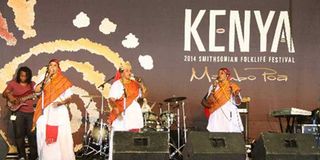Shame of the Kenya show in US

A Kenyan act at the Smithsonian cultural festival that ended in Washington, USA on July 5, 2014. PHOTO/Billy Odidi
What you need to know:
- To say that the Kenyan set-up was shambolic is an understatement. Actually, the organisational mess was a direct result of the incompetence displayed by officials of the Ministry of Sports, Culture and the Arts and was evident long before the artists left for the US capital.
- The unprecedented decision by the musicians to strike during the first weekend of the festival was the culmination of pent-up frustration over the handling of their welfare both in Kenya and in the US.
- Jabali Africa says their experience of touring the US since the 1995 has taught them that international audiences are dying to hear unique sounds from foreign lands.
So much has been written and said about the recent Smithsonian Folklife Festival in Washington DC that we may fail to carry out an honest assessment of the impact of this high profile event on Kenyan art.
The festival takes place on the parks of the National Mall surrounded by museums run by the Smithsonian Institution, within sight of powerful symbols of the American state, the Lincoln Memorial, the Washington Monument and the Capitol, which houses Congress.
It is within these grounds that each year since 1967, an international exhibition of music and dance, crafts and food is presented, an honour that was Kenya’s and China’s this year.
To say that the Kenyan set-up was shambolic is an understatement. Actually, the organisational mess was a direct result of the incompetence displayed by officials of the Ministry of Sports, Culture and the Arts and was evident long before the artists left for the US capital.
Rehearsals by musicians at the GoDown Arts Centre and at the Alliance Française ahead of the festival had been hit by interruptions with haphazard handling of US visa and travel arrangements.
The unprecedented decision by the musicians to strike during the first weekend of the festival was the culmination of pent-up frustration over the handling of their welfare both in Kenya and in the US.
VITAL LESSONS
Although the musicians returned to the stage a day later, as late as Monday evening after the end of the festival, there were still unseemly scenes between the artists and ministry officials at the Arlington hotel where the former were residing.
It is widely acknowledged that poor management has beset Kenyan music, and art in general, and is a major barrier to the progress of a sector that holds huge potential. It baffles that arguably the biggest ever stage to showcase Kenyan art may be remembered chiefly for the ignominy of the artists’ strike.
Is it possible to take any positives from the debacle in DC? Musicians formed the biggest part of the group that travelled to the US and the Ngoma Performance Stage was undoubtedly the highlight of the entire Kenyan showcase.
There were some really powerful performances by musicians on stage during the Festival and in other events on the sidelines of the festival. It is hard to quantify the benefits from such an event, but suffice it so say that the Folklife presented several vital lessons.
Musically, there must be a conscious decision to promote sounds that are distinct and therefore offer an advantage at an international level.
A look at the artists in DC provides a good illustration of the abundance of rhythms that can be marketed as the “Kenyan sound”. Performers who generally do get much mainstream attention like Doris “Chumba” Chepchumba, Kenge Kenge Orutu System, Makadem or even the all female group of singers from the Somali community, Gargar, were outstanding.
Singer-guitarist Winyo took his unique fusion of benga and the blues to concerts at the John F. Kennedy Center for the Performing Arts and the Library of Congress.
In a rare display of camaraderie, every night of the Festival, musicians would hold a jam session in their hotel with improvised and often spontaneous sets where Ayub Ogada would be strumming his Nyatiti with Jabali on drums, Eric Wainaina on vocals, as Makadem thumbed on the Kalimba.
Jabali Africa says their experience of touring the US since the 1995 has taught them that international audiences are dying to hear unique sounds from foreign lands. “You become a laughing stock if you bring pop or hip hop to Americans.
Unless there is a twist to the music that makes it striking to the fare they are accustomed to, then you are wasting time and effort,” Jabali’s Joseck Asikoye says.
BEST EFFORTS
His challenge to our musicians: Identify your own unique style and use every available platform to network with global connections in much the same way as musicians from other parts of Africa—Mali, Senegal, and even Nigeria—who have become success stories in World Music.
American music researcher Douglas Patterson, whose interest in Kenyan music goes back to the 1970s, says it is expensive to do tours in the US and therefore promoters in a huge music market like the States naturally opt for musicians with name recognition. This “comes about at events like the Folklife Festival or shows by renowned promoters but if there isn’t broader awareness of an artist’s recorded music through a CD release and radio airplay, then it is obviously a tough sell,” says Patterson, who was introducing the music acts at the Ngoma stage.
In his view, the Folklife Festival provides such a platform but without aggressive marketing to prepare the international audiences, then taking that next step to create money-making tours in the US or even in Europe will not be possible.
A vital lesson from the fortnight of events in Washington DC is that while its all well and good to produce quality artists as Kenya undoubtedly has, chaotic organisation can jeopardise the very best efforts of these very artistes.




